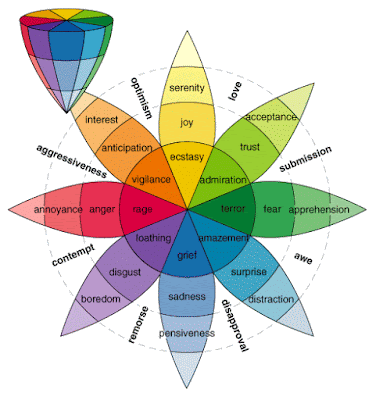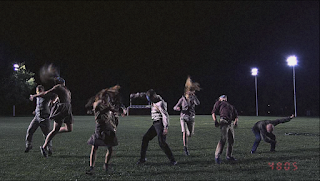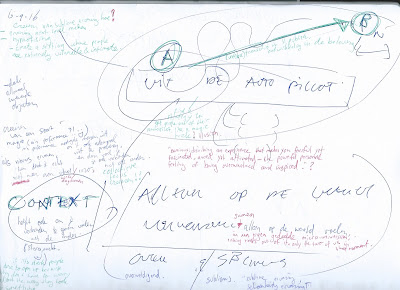" Everything is a medium."
---
Monday 12-9
So it was time to test out my little prototype.
I let people sit down, and told them to look into the binoculars, to stare into each other's eyes (for around 10 minutes, or as long as they could last. :) ) Hoping they would start to feel a mental connection at some point.... I also let them listen to random white noise, so they wouldn't be distracted by other sounds around them.
But this prototype really didn't produce the effect I was looking for. It didn't create that deep kind of connection which I wanted people to experience and feel.
The feedback I got from Frederik is mainly that you are
expecting something to happen, but nothing actually happens, and that's frustrating.
Maybe because my prototype lacked context. It wasn't clear what these binoculars
were supposed to do, or what the experience was supposed to do. What the
"story" was. And the fact that the audio only consisted of noise didn't give a clue either.
Then, I decided to just tell people what is supposed to happen
(namely that their brain activity would synchronize after a while, and
they would go into a sort of trance if they stared long enough.
http://www.iflscience.com/brain/you-can-alter-your-mind-staring-someones-eyes-10-minutes/page-2/ , ).... But I shouldn't have to explain beforehand. Good
immersive design should be self explanatory. I shouldn't have
to tell people what is
supposed to happen. They have to experience it for themselves.
Other reactions I got, is that looking this closely into someone's eyes (through binoculars), actually makes you forget you're sitting in front of a person, because the rest of the face can't be seen. And you can't see the other person's body language either, so you don't know what the other is feeling/thinking. So it's actually less confrontational. And I noticed that too actually, because after testing my prototype with someone, I actually found
talking about the experience, more confrontational than the experience itself. Looking into someone's eyes, sitting opposite of them and talking about what we had just experienced, created more of a connection between us, than my prototype did. Even though we were physically closer while testing the prototype.
My conclusion was that talking, sharing (thoughts, feelings) with another, is essential to feel connected to someone. Eye contact comes perhaps second. Kind of obvious, now that I think about it...
At the end of the day Frederik left us with these words:
-
There should be a defined endpoint (I didn't have that yet)
- What is the goal I want to achieve? Communicate this.
- Direct the experience/story
- The faster you dare to sketch/prototype, the more you liberate yourself.
So after today I knew that I should somehow incorporate -talking- into my project, because eye contact simply wasn't enough. But
how would I incorporate this?! .. What should I let people talk about?
_________________________________________________________________________
Tuesday 13-9
I told Marcel about the fact that my prototype actually didn't work, it was talking about the experience, that created more of a connection. So I felt lost, I didn't really know what to do anymore.
But he helped figure me out, and reminded me, of what exactly it was that I was hoping to achieve, with this project. What kind of feeling in the audience I was trying to elicit. Namely; the deepest kind of connection between two people; empathy; relating to; sharing; seeing (parts of) yourself in someone else.
So in order to make people feel connected they had to share secrets, or personal stuff with each other. But how? Marcel came with the suggestion that maybe I should act as a character, who has a backstory and everything. I ask the audience personal questions, and hopefully they ask me things back in return, and through this ongoing conversation a connection will start to emerge.
While I found this idea really interesting and fun, I later thought to myself that this wasn't right... I didn't want to come up with some story and
act, because then the connection wouldn't be pure. It would be fabricated.
So now I felt stuck again.
_________________________________________________________________________
Wednesday 14-9
Still looking for a solution.
Talking, talking, how will I incorporate this?!
I looked up some methods to create a mental connection. But then I thought to myself; I usually connect when I have a deep conversation with someone and really get to know them. A good, deep discussion can touch you, just like a good story or an
artwork can. Talking with someone can be extremely immersive, if you connect. But making people talk to each other, just for my project, is kind of weird.
So then I had a new idea; I would ask people personal questions, and record their answers. Then I would look for similar answers in those recordings, pair those answers together, put them in 1 audiofile, and then let those people listen to each other's answers. As if they were talking to each other, or reading each other's minds.
And hopefully they will recognize parts of themselves in the other person, this way.
The questions I decided to ask:
- What are your dreams?
- What have you been afraid of ever since you were a child?
- Do you feel lonely? Have you ever felt lonely? And how would you define loneliness?
- When do you feel like you have a connection with someone?
_________________________________________________________________________
Thursday 15-9
Nienke gave us a lecture on the medium film, and its development. And now that new mediums are starting to emerge, the way we tell stories has to change.
Some projects she showed us, that I found inspiring:
The Johnny Cash project
Fans could each draw 1 frame of the videoclip. It raises an interesting question: What if I extend my authorship to my audience?
Another work I really, really loved is a music video that Vincent Morrisset worked on. For
Arcade Fire - Sprawl II (Mountains beyond Mountains)
You have to dance in front of your webcam, if you want the music video to play. A dance activated video!! Really fun concept.
And last but not least, Vincent Morisset's
"Bla Bla" . an interactive film for computer.
Something that was also mentioned is that we need to think about how we want to bring our work out into the world. In what context, to whom, etcetera.
We as (art) students only learn
the 3 stages of making work: development, production & post
production. But we should also think about the steps that come after that, namely:
building a community/fanbase // engagement design // story world expansion // distribution /marketing // funding // collaboration // presentation (at festivals for example) // etcetera.
---
So, after the lecture I interviewed some classmates, and I also answered the questions myself.
Later that evening I edited the audio. And now I just had to wait for tomorrow, to see if my newest idea
would create that deep connection between people.
_________________________________________________________________________
Friday 16-9
Presentation day.
So it was time to test my idea.
No more binoculars.. People only had to look into each other's eyes and listen to each other's answers.
Two of my human guinea pigs, Annemaaike & Quintus, listening to each other's answers:
Because I also answerd my questions, I also paired myself up with a few people. And it felt really intimate, and confrontational. Hearing my own answers to such personal questions, and knowing that the other can hear them too.. it was kind of scary. But I also heard their answers, so it was also like I was inside their head. And because I had to look into the other's eyes the entire time, I felt very vulnerable too.. But, because we had similar answers, I recognized parts of myself in the other, so I did feel that connection that I was hoping to find. I also noticed that our blinking sometimes synchronized, and that's really creepy, but also really cool.
It was so beautiful to see other people "synchronizing" too. Really strange, but also really fascinating. I was really amazed that this little experiment turned out so well.
What I would do differently next time; create a much more intimate, comfortable setting. Because now bystanders could watch, but that was not my intention. This was really supposed to be a 1 on 1 experience.
_________________________________________________________________________
So how did I find this 2-week workshop? Well amazingly, because of the short amount of time we had, I dared to take steps faster, because I had less time to doubt myself.
And in the end I managed to achieve my goal. I'm very, very happy that I was able to touch others with my last experiment. And I was also really touched by everyone's answers, I recognized myself in a lot of people, and it reminded me that connecting with other people really isn't that hard, as long as you dare to open up.
I'm also happy that I managed to immerse people just with audio and prolonged eye contact. I want to continue creating immersive experiences with the least amount of tools as possible.
I also want to play more with human psychology, get inside people's heads, and engage the deepest parts of our psyche. How, I have not decided or figured out yet.
I also didn't really create a story for this project, I merely generated an experience. Or perhaps the people's answers created the story. However, I actually like working like this, and want to do this more often, that way the audience can take what they want from the experience and create their own story.


































